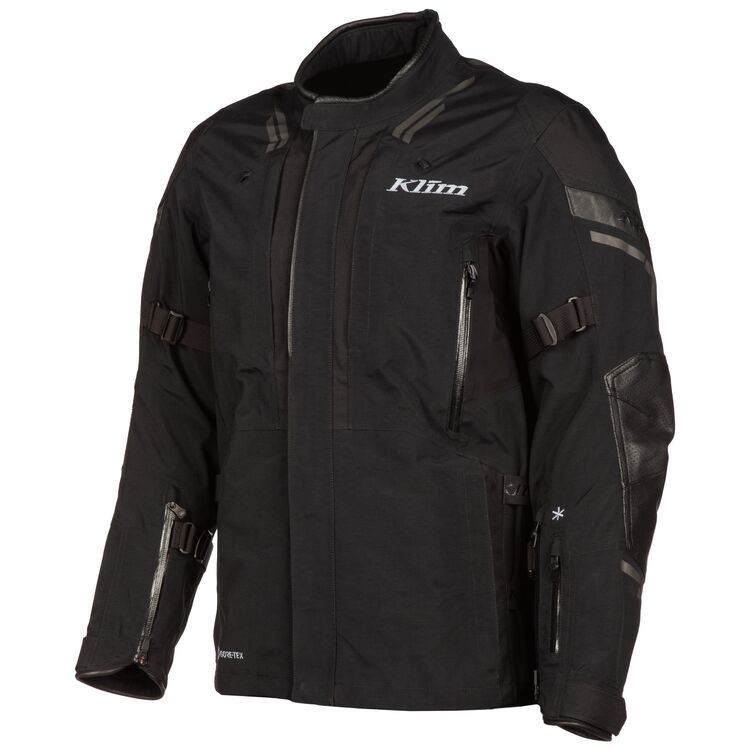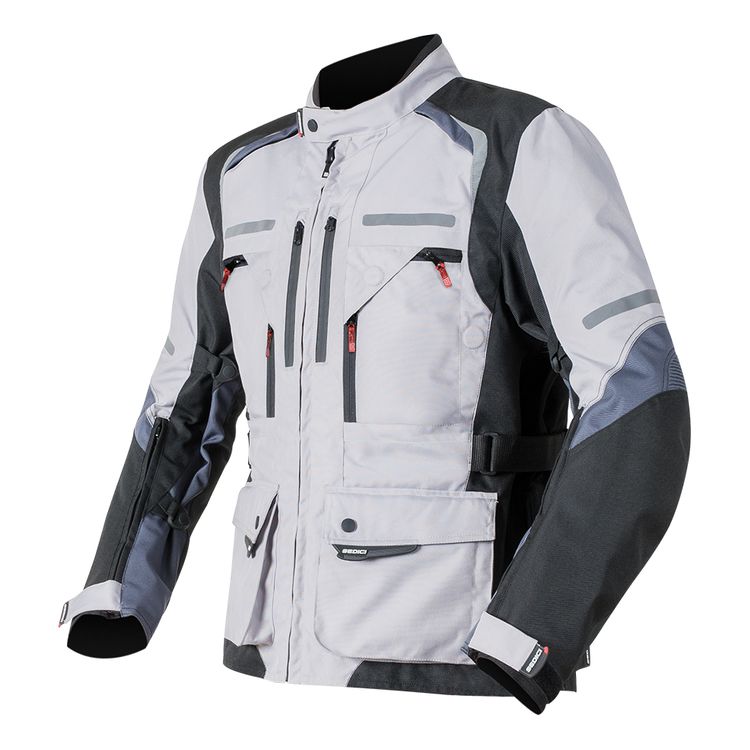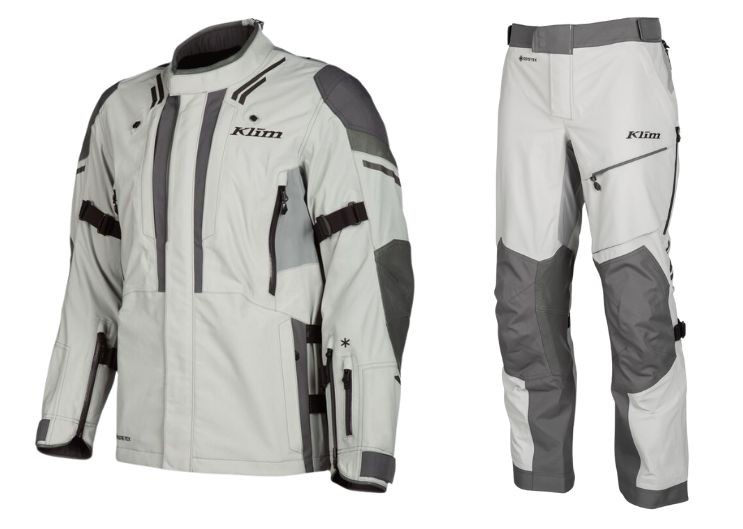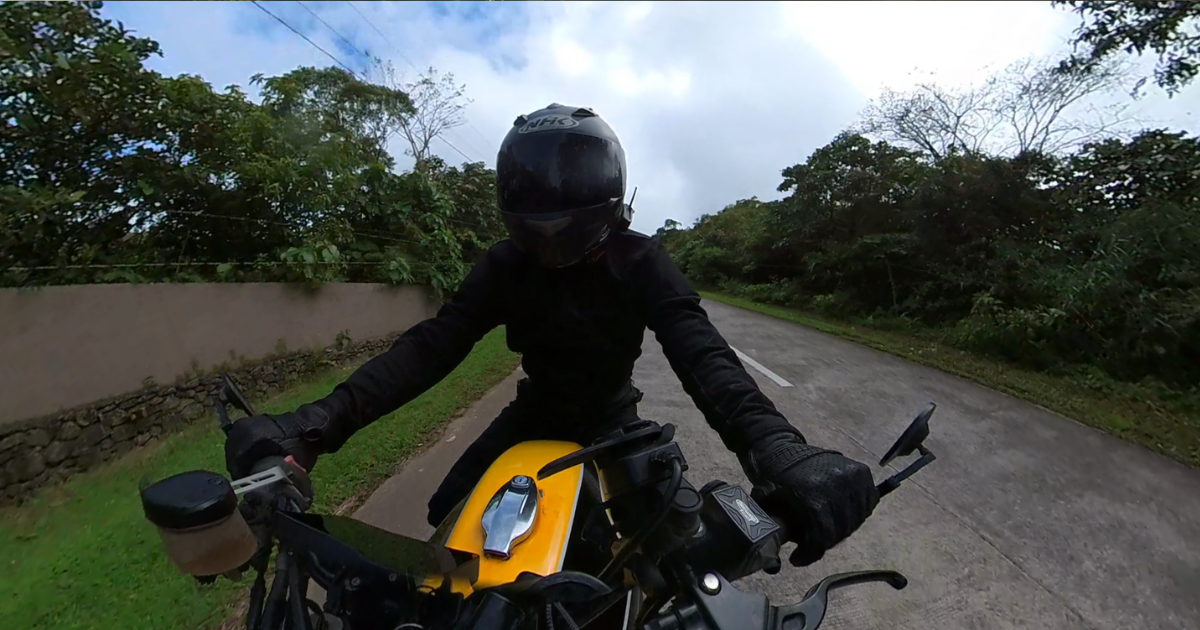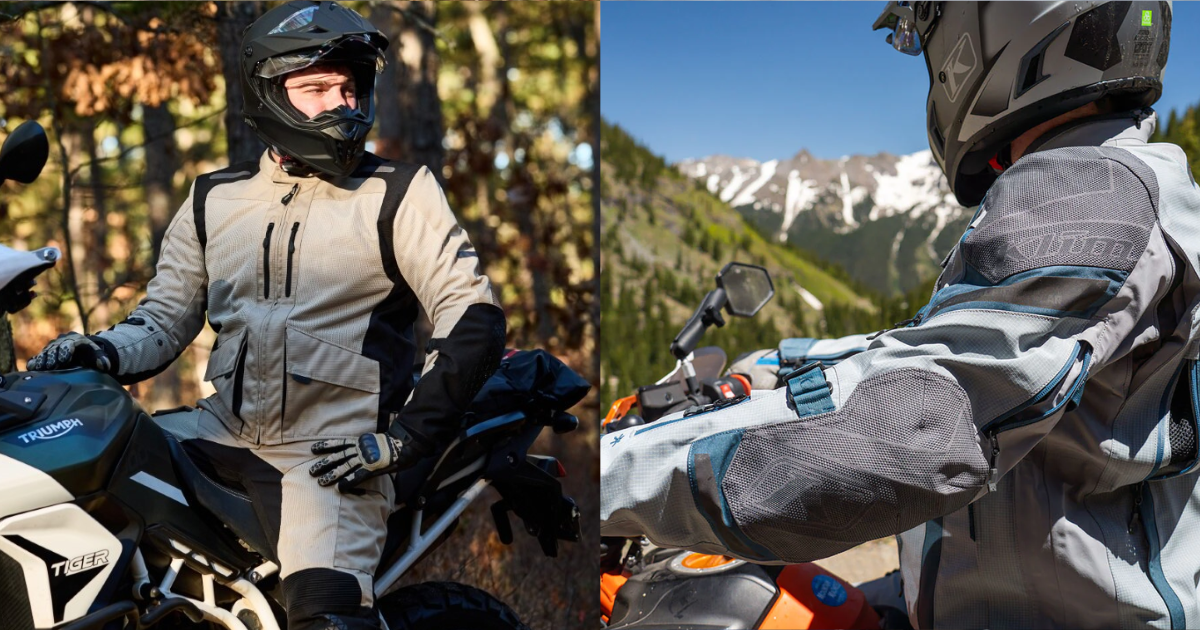
Sedici Avventura vs Klim Latitude: Rider’s Jacket Showdown
left for contents
Every adventure rider eventually faces the same question: spend big on a laminated shell that just works, or save money with a layered / liner system that demands more management? It’s a choice between convenience and cost.
The Klim Latitude and Sedici Avventura represent these two philosophies. One costs roughly $800 and promises Gore-Tex reliability in a fully laminated shell. The other sits around $280 and uses removable liners to keep costs down, asking riders to zip layers in and out depending on conditions.
I’ve faced this choice before: I wore the Sedici Marco Mesh 2 (cheap with waterproof liner) on part of my ride across the USA in 2022. And I hated that liner. If I did it over again, I’d go for the more premium laminated shell! But budget was a bigger concern back then…
Klim’s Latitude suit blends Gore-Tex waterproofing, smart ventilation, and CE armor to deliver all-season touring protection and comfort. | Designed for adventure riders, offering waterproof protection and durability. |
|
|
|
|
Klim’s Latitude suit blends Gore-Tex waterproofing, smart ventilation, and CE armor to deliver all-season touring protection and comfort.
- Keeps you dry in heavy rain
- Strong ventilation for hot rides
- D3O armor in key impact zones
- Stretch panels for easy movement
- Armor is only Level 1
Designed for adventure riders, offering waterproof protection and durability.
- Budget-friendly waterproof layering system
- Removable liners adapt to changing weather
- CE Level 2 armor at shoulders and elbows
- Multiple vents for airflow on warm rides
- Adjustable fit for comfort and flexibility
- Liners can be annoying to manage
Both jackets can handle a variety of conditions (as any good adventure jacket should), but neither is flawless. Your decision ultimately comes down to how you ride, where you go, and what trade-offs you’re willing to make for comfort, protection, and convenience.
Quick Verdict
Who should buy the Klim Latitude
- Budget is less important than comfort
- Riders who want a laminated Gore-Tex shell that stays dry without fiddling with liners. The Latitude’s two-layer construction lets you ride through rain without stopping.
- Tourers prioritizing long-term comfort and fit. Stretch Gore-Tex gussets in the shoulders and articulated panels reduce fatigue on multi-day trips, and the jacket’s weight (~5 lb) spreads evenly with a quality back protector.
- Those who prefer a premium finish and reputable brand support. D3O armor, goat-leather overlays and 3M reflective trims deliver high-end protection and visibility, and Klim’s lifetime warranty backs the investment.
Klim’s Latitude suit blends Gore-Tex waterproofing, smart ventilation, and CE armor to deliver all-season touring protection and comfort.
- Keeps you dry in heavy rain
- Strong ventilation for hot rides
- D3O armor in key impact zones
- Stretch panels for easy movement
- Armor is only Level 1
Who should buy the Sedici Avventura
- Budget is tighter than your appetite for adventure. At roughly $280, it delivers waterproof and thermal liners, CE Level 2 elbow and shoulder armor and ample storage. Pretty good deal.
- Commuters and weekend adventurers who ride in varied weather and don’t mind adding or removing liners. The Avventura’s 3-layer system makes it versatile from winter commutes to summer backroads.
- Riders who like adjustability. The jacket has a waist belt, sleeve take-up straps and chest vents/sleeve zippers to dial in fit and airflow.
Designed for adventure riders, offering waterproof protection and durability.
- Budget-friendly waterproof layering system
- Removable liners adapt to changing weather
- CE Level 2 armor at shoulders and elbows
- Multiple vents for airflow on warm rides
- Adjustable fit for comfort and flexibility
- Liners can be annoying to manage
Is the Klim Latitude Worth the Extra $500?
Depends on your budget and the adventures you’re going on. What I can confidently say is that good gear on a multi-day adventure easily pays for itself, whereas bad gear can ruin the entire trip. I’ve found this true not just in motorcycling, but with camping, hiking, running. Especially when you can’t change gear or quit before the trip is over.
So in that sense, if budget allows, I’d say go with the Klim Latitude. That premium buys laminated Gore-Tex waterproofing, lighter and more pliable materials, refined fit, integrated D3O armour and lifetime warranty support. If your priority is a truly waterproof shell and long-term durability, the extra outlay is justified; if you mainly need versatile protection at a friendly price, the Sedici delivers strong value.
At-a-Glance: Specs & Price
| Feature | Klim Latitude (2022/23) | Sedici Avventura Waterproof |
|---|---|---|
| Weight | ~5 lb for size Large with back protector | ~6.4 lb shipping weight (multi-layer design) |
| Fit/Shape | American touring fit with adjustable biceps, forearm and hip straps; runs slightly large—most riders size down if between sizes | Regular adventure cut; adjustable waist belt and sleeve take-ups help manage bulk; runs true to size but may feel snug with both liners installed |
| Shell/Materials | 2-layer Gore-Tex laminated shell; stretch Gore-Tex panels; 600D Cordura overlays on shoulders; perforated goat-leather elbow reinforcements | 450D abrasion-resistant Oxford shell; removable 100% waterproof breathable liner and quilted thermal liner; Airflow mesh lining |
| Protection/Certification | D3O Level 1 shoulder and elbow armour; D3O Viper CE Level 1 back pad; garment rated to CE Class A (EN 17092-4) | CE Level 2 shoulder and elbow armour (AXIAL AX2); pocket for optional back protector |
| Ventilation/Weatherproofing | Dual-cuff vents, chest and back vents, 2 zippered hip gussets; laminated Gore-Tex shell remains waterproof without a liner | Air Control System with chest vents, two-way sleeve vents and back exhaust; waterproofing relies on removable liner; thermal liner can be zipped out for summer |
| Electronics/Battery | None; integrates with modern comms via pass-through headphone loops and glove-friendly pockets | None; features internal media pocket with headphone port |
| Warranty | Limited lifetime warranty on materials and workmanship | 2-year warranty (through Cycle Gear/Comoto) |
| Street Price | MSRP ~$800; street prices $700–$829 new, occasional clearance around $560 | MSRP ~$279.99; sales around $210–$250 |
The Philosophy Gap: Laminated vs Drop-Liner
Before we dive into zippers and pockets, understand the core difference. The Klim Latitude uses a two-layer laminated construction: the waterproof Gore-Tex membrane is bonded directly to the outer shell. Water never gets past the surface. The jacket is always waterproof, always breathable, and you never think about adding a liner. You layer underneath for warmth—heated vest, fleece, merino base—but the shell itself handles rain.
The Sedici Avventura uses a three-layer drop-liner system: an outer shell, a separate waterproof liner that zips or buttons inside, and a thermal liner for cold weather. Each piece does one job. Want ventilation? Remove the waterproof liner. Need warmth? Add the thermal. Caught in rain? Stop, unpack, insert the waterproof liner, zip everything back together, ride on. It’s more versatile on paper, but it demands active management.
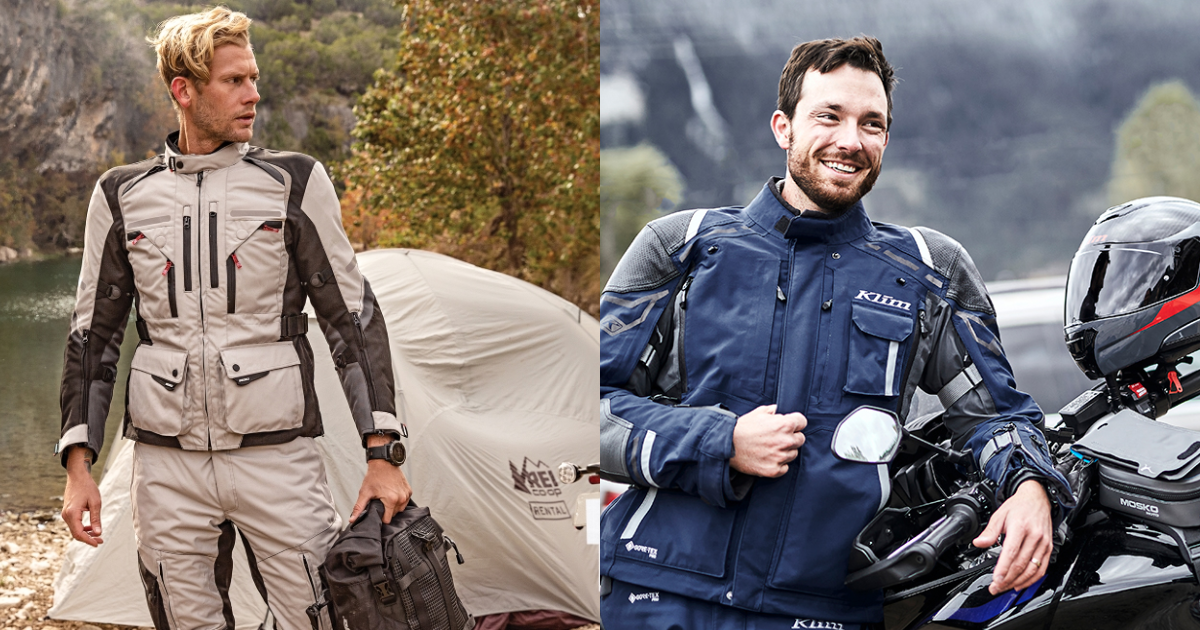
Neither approach is wrong. Laminated shells excel at simplicity and consistent performance. Drop-liner systems excel at adaptability and cost. Your riding style determines which philosophy wins.
Choose Klim Latitude if:
If you ride long distances in unpredictable weather, the laminated Gore-Tex shell keeps you dry without adding liners. It shrugs off downpours and fog, letting you keep moving instead of stopping to zip layers. Rain or shine, the jacket handles it all on the fly.
Comfort matters on multi-day tours. Stretch panels, articulated sleeves, and a soft collar give it a tailored feel instead of a stiff ADV fit. After 300 miles in the saddle, that difference is huge.

D3O armor at the back, shoulders, and elbows offers CE Level 1 protection, while reflective trim boosts visibility. Eight exterior and four interior pockets keep things organized without looking bulky. Add Klim’s lifetime warranty, and you’ve got long-term peace of mind.
Choose Sedici Avventura if:
You want an affordable jacket that still covers the ADV touring basics. At around $280, the Sedici Avventura offers waterproofing, insulation, and CE Level 2 armor where many budget options fall short. It’s a smart choice for riders building their first kit or exploring ADV riding without a big financial risk.
Versatility matters more than laminated waterproofing. Removable thermal and waterproof liners let you adapt to cold winters and hot summer rides—just plan a quick stop to zip them in or out. One jacket handles February commutes and July canyon runs with ease.

A relaxed fit and multiple adjusters make it easy to dial in comfort. Waist belts, sleeve straps, and side adjusters accommodate extra layers and different riding setups. Generous storage—large cargo, chest, and rear utility pockets—keeps essentials within reach. Add a CE back protector for $40–$80, and you’ve got a complete, flexible setup at a fraction of the cost of premium gear.
Head-to-Head by Category
Protection & Safety Ratings
Latitude: Klim’s Gore-Tex laminated shell resists abrasion inherently, supplemented by 600D Cordura overlays on the shoulders and goatskin reinforcements on the elbows. It ships with D3O LP1 Level 1 armour in shoulders and elbows plus a D3O Viper back pad—all vented for comfort. The entire garment is certified to CE Class A under EN 17092-4, reflecting tested abrasion and tear resistance. Reflective 3M Scotchlite trim across chest, arms and back enhances visibility at night.
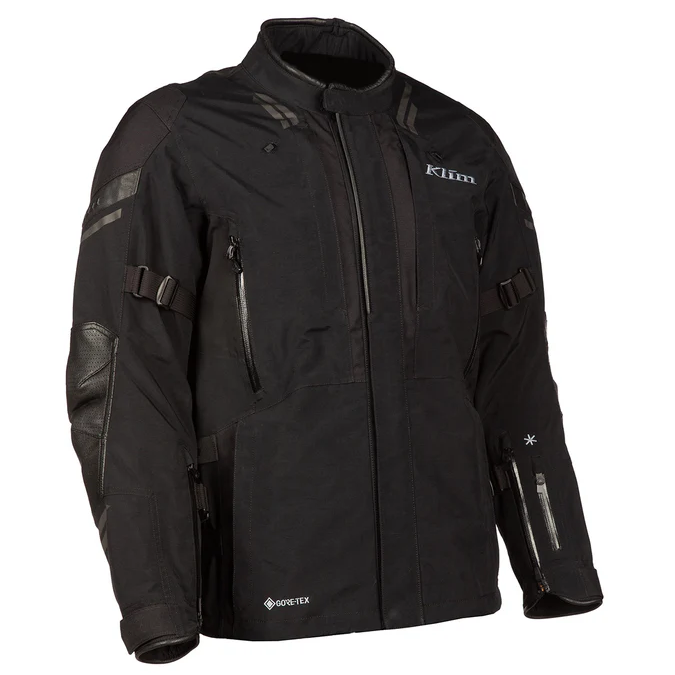
The included back protector is the defining safety advantage. Most jackets in this category make you buy protection separately; Klim includes it, properly sized and positioned.
Avventura: The 450D Oxford shell offers respectable abrasion resistance for the price, though it lacks the certification of a laminated system. CE Level 2 shoulder and elbow armour (AXIAL AX2) actually exceeds the Latitude’s Level 1 pads in impact absorption—a genuine win at this price point.

The missing back protector is the major gap. The jacket has a pocket for one, but you’re shopping for aftermarket protection before the first ride. Reflective prints across the upper back and arms provide some night visibility, though coverage is less extensive than Klim’s 3M treatment.
Weather Range & Ventilation
Latitude: Waterproof immediately and always. No liners to remember, no stops to reconfigure. The laminate handles everything from Pacific drizzle to Arizona monsoons. For cold weather, you layer underneath—heated vest, fleece mid-layer, merino base—but the shell itself never changes.
Ventilation is impressively effective. Dual-cuff vents pull air up the sleeves, large chest and back vents exhaust heat, and zippered hip gussets relieve pressure when seated. Open everything on a 75°F day and airflow rivals mesh jackets. Push into 95°F+ conditions and the jacket still feels warm, but that’s physics; you’re wearing a waterproof membrane.

The trade-off is that the jacket remains light and dry even after hours in rain—the laminate doesn’t absorb moisture.
Avventura: Ships with two liners: a waterproof/breathable drop-liner and a quilted thermal liner. Use them separately or together. Cold mornings? Both liners keep you warm down to around 40°F with a base layer. Hot afternoons? Remove both to reveal a mesh-lined shell; chest intakes and two-way sleeve zippers flow air reasonably well.
The catch: rain requires inserting the waterproof liner beforehand. Caught without it? You’re getting wet, and the outer shell will soak up water like a sponge, adding weight. After heavy storms, the fabric holds moisture and takes time to dry.

This isn’t a flaw—it’s the nature of drop-liner systems—but it demands awareness and planning.
Thinking about lighter Klim gear for warmer rides? Our Klim Baja S4 vs Marrakesh breakdown compares mesh ventilation, comfort, and protection in hot conditions.
Comfort & Fit
Latitude: Pre-curved arms, stretch gussets and articulated cuffs make the Latitude feel tailored rather than off-the-rack. The fit is generous; most riders size down for a closer profile. Bicep and forearm straps keep armour positioned correctly, and hip gussets allow expansion when seated.
The collar lining is soft against skin—no raw edges or stiff seams. A cinch cord adjusts neck closure for varying speeds. At roughly 5 lb, it’s not light, but the weight balances well. Most of the mass comes from the back protector and armour, which distribute load across shoulders rather than hanging awkwardly.

Some riders mention minor collar rubbing during the first few rides, but break-in is quick. After a week the jacket moves with you rather than against you.
Avventura: Standard ADV cut with room for layers. The internal waist belt pulls the jacket closer to the body, preventing flapping at highway speeds. Sleeve and cuff adjustments dial fit over thick gloves. With both liners installed, the jacket feels snug—removing one liner significantly improves mobility.
The tall collar provides wind protection but feels stiff when new. Give it time to soften. Overall comfort is good for the price, though longer rides sometimes reveal pressure points, especially when the saturated waterproof liner adds bulk.

Riders on multi-day trips report the jacket feeling heavier by day three, whereas the Latitude maintains consistent comfort.
Curious how these brands handle summer airflow and comfort? Our Klim Induction Pro vs Sedici Marco comparison dives into ventilation, materials, and value.
Storage & Features
Latitude: External storage includes two chest pockets, two hand pockets, two forearm pockets (one specifically for emergency ID), and a large concealed document pocket behind the back protector. Four internal pockets handle electronics and papers. Every pocket is accessible with gloves on, and YKK zippers operate smoothly even in cold or wet conditions.

A full-length pants connector zip pairs with Klim Latitude pants or other Klim trousers for integrated coverage. Pass-through headphone loops integrate with modern comms systems without requiring external routing.
Avventura: Two chest pockets and two lower cargo pockets with flap closures dominate the front. A rear utility pocket holds wet gloves or a neck gaiter—genuinely useful when conditions change mid-ride. Inside are two Napoleon pockets and a cell-phone pocket.

Zippers are medium-duty; the wrist zips are long and double as vents. Reflective graphics across the back improve night visibility. There’s no pants connection zip, so pairing with different brands requires a universal connector belt—annoying if you own Sedici pants, manageable if you’re mixing brands anyway.
Value for Money: Is the Upgrade Worth It?
The extra $500–$550 for the Klim Latitude primarily pays for its Gore-Tex laminated shell. Laminates keep water out while letting moisture escape, maintain consistent weight in wet conditions, and typically outlast drop-liner systems by years. Premium touches like goatskin and Cordura reinforcements, 3M reflective trim, smoother zippers, and better articulation further elevate the build.
Klim’s Latitude suit blends Gore-Tex waterproofing, smart ventilation, and CE armor to deliver all-season touring protection and comfort.
- Keeps you dry in heavy rain
- Strong ventilation for hot rides
- D3O armor in key impact zones
- Stretch panels for easy movement
- Armor is only Level 1
For riders logging long miles in unpredictable weather, the Latitude quickly pays for itself through comfort and reliability. A jacket that performs flawlessly for 5–10 years offers excellent cost per use. The Sedici Avventura, at $280, delivers CE Level 2 protection, two liners, and ample touring features at a much lower price. If you’re willing to manage liners, it’s a solid value.
Designed for adventure riders, offering waterproof protection and durability.
- Budget-friendly waterproof layering system
- Removable liners adapt to changing weather
- CE Level 2 armor at shoulders and elbows
- Multiple vents for airflow on warm rides
- Adjustable fit for comfort and flexibility
- Liners can be annoying to manage
Adding a quality back protector brings the Avventura closer to $350–$380, narrowing the gap. Still, for shorter rides or strict budgets, it remains compelling. Frequent riders with extra budget will notice the Latitude’s advantages in daily use.
Looking at premium adventure gear beyond the Latitude? We tested the Klim Badlands Pro A3 to see how it performs on long-haul ADV rides.
The Bottom Line
The Klim Latitude and Sedici Avventura represent two legitimate approaches to adventure riding gear. The Latitude buys simplicity, consistent performance, and premium protection at a premium price. The Avventura buys versatility, adequate performance, and genuine value at a budget price.
If you ride long distances through unpredictable weather, prioritize comfort on multi-day trips, and want gear that just works without active management, the Latitude justifies its cost. The Gore-Tex laminate, included back protector, refined fit, and lifetime warranty deliver measurable value over years of use.
If you’re building your first ADV kit, ride primarily shorter distances, or are willing to manage removable liners for maximum versatility, the Avventura delivers impressive capability for the money. Add a back protector and you have legitimate four-season protection for under $400.
Klim’s Latitude suit blends Gore-Tex waterproofing, smart ventilation, and CE armor to deliver all-season touring protection and comfort. | Designed for adventure riders, offering waterproof protection and durability. |
|
|
|
|
Klim’s Latitude suit blends Gore-Tex waterproofing, smart ventilation, and CE armor to deliver all-season touring protection and comfort.
- Keeps you dry in heavy rain
- Strong ventilation for hot rides
- D3O armor in key impact zones
- Stretch panels for easy movement
- Armor is only Level 1
Designed for adventure riders, offering waterproof protection and durability.
- Budget-friendly waterproof layering system
- Removable liners adapt to changing weather
- CE Level 2 armor at shoulders and elbows
- Multiple vents for airflow on warm rides
- Adjustable fit for comfort and flexibility
- Liners can be annoying to manage
Neither jacket is perfect. The Latitude demands a larger investment and doesn’t pack small. The Avventura requires liner management and doesn’t match laminated waterproofing. But both will get you down the road safely in varied conditions—one with less fuss, one with less cost. Choose based on how you ride, not just what you can afford.
Related
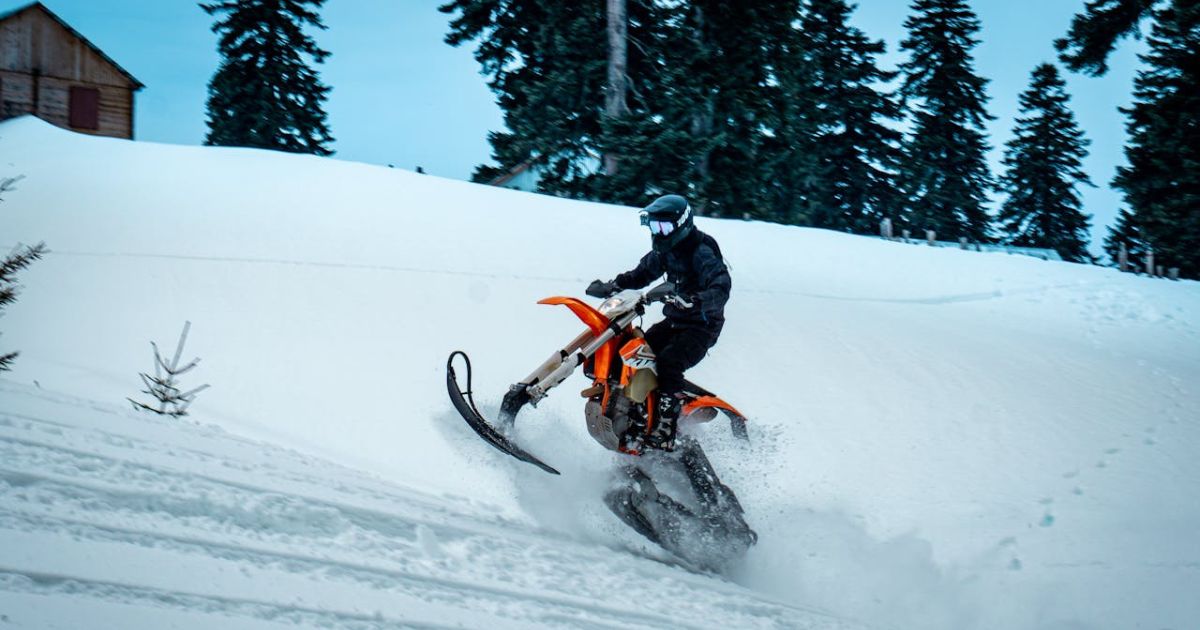
Best Snowmobile Jackets to Keep You Warm
Find the best snowmobile jackets for 2025 with top picks for warmth, waterproofing, and performance—whether you ride trails, tackle backcountry climbs, or work outdoors.

